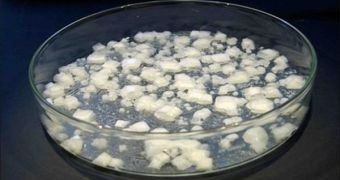Since it was shown in chemical experiments that the “primordial soup” could have led to the formation of complex proteins and nucleic acid strands from amino-acids over time, experts have been trying to model this in the laboratory, with various degrees of success. Now, German researchers at the University of Hohenheim, in Stuttgart, announce that amino-acids can easily be “cooked” into other important building blocks of life, if they are incorporated in salt crusts, AlphaGalileo reports.
Dr. Stefan Fox, the leader of the research team, will present the finds today, at the European Planetary Science Congress, held in Potsdam, Germany. Some 4.5 to 3.8 billion years ago, geologists believe the planet was partially covered by a salt-rich ocean, which contained numerous organic molecules, but no discernible life form, not even on the most basic level. The landscape was dotted by active volcanic islands and short-lived continents, which succeeded very fast one after the other.
So, the German investigators set out to simulate this Hadean environment. They evaporated solutions of artificial primordial seawater, and then subjected the ensuing salty residues in the atmosphere (which was then made up of nitrogen and carbon dioxide) to temperatures similar to those found near active volcanoes, of about 350 degrees Celsius. Their study immediately revealed that compounds such as pyrroles were formed. These chemicals can be found in chlorophyll and in heme even today. The latter is a substance found in hemoglobin, which allows for oxygen to be trapped in the blood.
The secret of obtaining these chemicals lies in the interactions that amino acids have with metal ions derived from crusty salts. At high temperatures, these ions prevent the other compounds with which they bound from turning into gas. “We embedded the amino acid DL-alanine in a salt crust mixture of sodium, calcium, potassium and magnesium chlorides and, after heating, we found that a compound formed with calcium salt chemically bonded to the amino acid,” Fox explained.
“This particular compound has never been seen before and, although similar compounds are known to exist, we did not expect to see them in our experiments. This bond between the salt and the amino acid stabilizes the compound at high temperatures and prevents sublimation. Without the bond, pyrroles would not be able to form,” he concluded.

 14 DAY TRIAL //
14 DAY TRIAL //